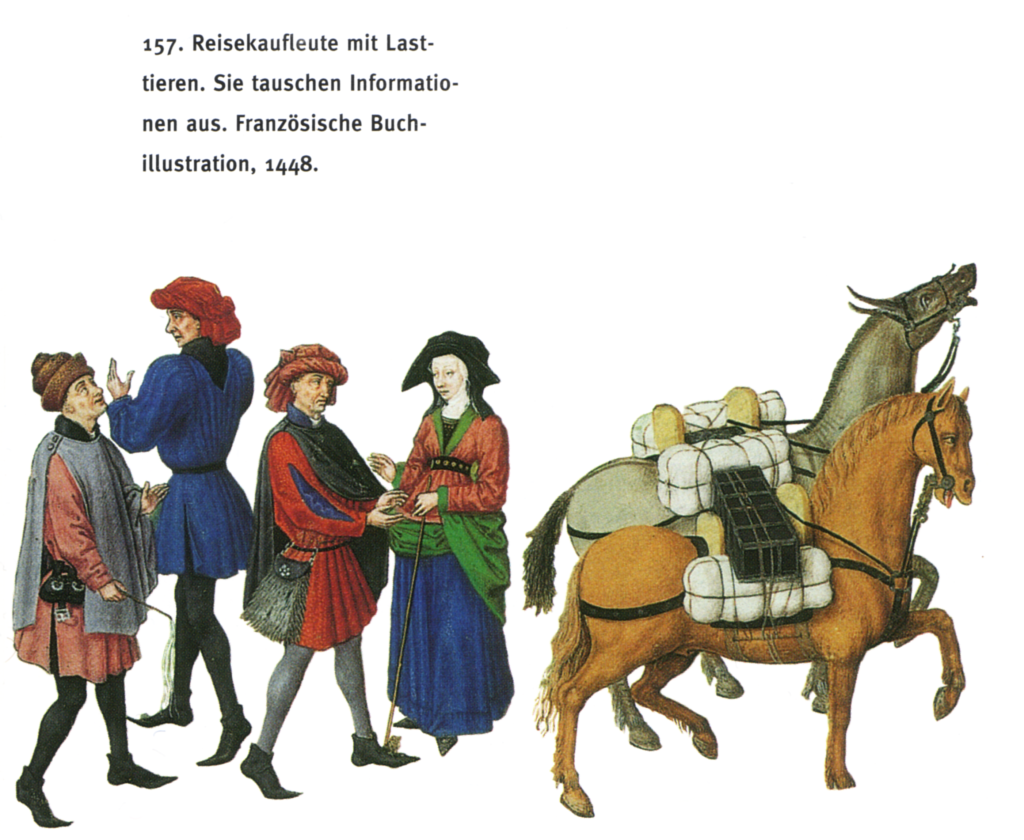There's a picture in my personal image database that has irked me for ages now. It's from a popular science book about the Middle Ages:
Hägermann, Dieter: Das Mittelalter. Die Welt der Bauern, Bürger, Ritter und Mönche. RM Buch und Medien, 2001.
There are plenty of illustrations in that book, and some of them state where they are from (or at least roughly), some of them don't. Of course, I'm talking here about one from the latter category. I've been looking for that image ever since I've seen it in the book, but to no avail - but maybe someone of you has?
Here it is:
[caption id="attachment_6015" align="alignnone" width="412"] From Hägermann, Dieter, p. 154. The description says "Travelling merchants with pack animals. They exchange information. French book illustration, 1448."
From Hägermann, Dieter, p. 154. The description says "Travelling merchants with pack animals. They exchange information. French book illustration, 1448."
This might have been a marginal illustration somewhere, as it has been cut out from the background; some of the marginal images from the Luttrell Psalter have been treated similarly for the book. It might be a cut-out part from a "proper" image, too, though - the style somehow looks not so marginal to me. But then, I'm no expert on illuminations. I'd just really, really like to know where this comes from, so I can cite it properly and learn about the context and maybe see if there's more like it in the same manuscript - because it's one of the rare images where you have a woman merchant/traveller among the group, and I find that wonderful and fascinating.
So. Have you seen these merchants, by chance? Or do you know any similar pictures of travelling merchants that include women? Please let me know!
Update: They have been found. You can read about who did it, and where they are from, here.
Hägermann, Dieter: Das Mittelalter. Die Welt der Bauern, Bürger, Ritter und Mönche. RM Buch und Medien, 2001.
There are plenty of illustrations in that book, and some of them state where they are from (or at least roughly), some of them don't. Of course, I'm talking here about one from the latter category. I've been looking for that image ever since I've seen it in the book, but to no avail - but maybe someone of you has?
Here it is:
[caption id="attachment_6015" align="alignnone" width="412"]
 From Hägermann, Dieter, p. 154. The description says "Travelling merchants with pack animals. They exchange information. French book illustration, 1448."
From Hägermann, Dieter, p. 154. The description says "Travelling merchants with pack animals. They exchange information. French book illustration, 1448."This might have been a marginal illustration somewhere, as it has been cut out from the background; some of the marginal images from the Luttrell Psalter have been treated similarly for the book. It might be a cut-out part from a "proper" image, too, though - the style somehow looks not so marginal to me. But then, I'm no expert on illuminations. I'd just really, really like to know where this comes from, so I can cite it properly and learn about the context and maybe see if there's more like it in the same manuscript - because it's one of the rare images where you have a woman merchant/traveller among the group, and I find that wonderful and fascinating.
So. Have you seen these merchants, by chance? Or do you know any similar pictures of travelling merchants that include women? Please let me know!
Update: They have been found. You can read about who did it, and where they are from, here.



